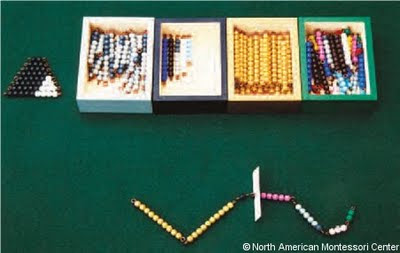A recent response to one of my students’ questions prompted me to share it with our blog readers. I think it represents a critical, defining intention of the Montessori method. The question is paraphrased here:
“I don’t know why we should bother to teach students this [Subtraction Snake Game] when there is a much easier way and I could simply show them the shortcuts to reach the final result. Am I missing the point to these tedious materials?”
The Subtraction Snake Game - How Montessori Materials Help Students Learn to Love Learning
This was my response:You have asked a valid question regarding showing students ‘shortcuts’ or easier ways than using the Montessori materials. You asked if you were missing ‘the point’. First, let me thank you for asking. Conventional education reasons that if you teach children the easy way or the shortcuts, the students will “get it faster” and you can simply move on to the next lesson. Conventional education tells children “trust me”; the adult is the all knowing giver of information and the child is the empty receptacle waiting to be told how to do something.
Once the child does this “thing”, they wait until they are told how to do more. Conventional education is about the product. If you can do it faster, you can produce more. More, in this case, is “good”.
Montessori education is about the process. Montessori theory (and Constructivism) states that when children understand why something is the way it is and they have constructed this knowledge themselves by using didactic materials, not only do they have a firm foundation from which to move forward, but they also become more self-reliant. They do not need to wait for the omniscient and omnipotent adult to tell them what they need to know; they can discover by themselves.
 By constructing their own knowledge (and reality) children discover the shortcuts themselves and own that “Ah ha!” moment and readily seek out the next challenge. They build deeper connections because they understand the workings and concepts behind the concrete material which leads to greater abstraction of thought than can be given by simply telling them how to perform a shortcut.
By constructing their own knowledge (and reality) children discover the shortcuts themselves and own that “Ah ha!” moment and readily seek out the next challenge. They build deeper connections because they understand the workings and concepts behind the concrete material which leads to greater abstraction of thought than can be given by simply telling them how to perform a shortcut. By giving children the answers/short-cuts we rob them of that “Ah ha” moment of self-actualization. Montessori education may seem ‘slower’ because of this, but in actuality, building that process knowledge leads to greater development of product. (Think: work smarter, not harder).
Montessori cautions her educators to avoid leaping over the “abyss separating the concrete from the abstract.” She states that the Montessori teacher should be trained to simply make experiments. In Montessori’s words: “The answer she expects from the child is that he should be interiorly moved to use the material presented to him” and the lesson “…should not have anything about it that is not the absolute truth.” (Maria Montessori, The Discovery of the Child)
There is so much more to the simplicity of the Montessori lessons than meets the eye, and all of it is there in the Montessori material, waiting to be discovered.
As much as possible, NAMC’s web blog reflects the Montessori curriculum as provided in its teacher training programs. We realize and respect that Montessori schools are unique and may vary their schedules and offerings in accordance with the needs of their individual communities. We hope that our readers will find our articles useful and inspiring as a contribution to the global Montessori community.
© North American Montessori Center - originally posted in its entirety at Montessori Teacher Training on Friday, July 8, 2011.
© North American Montessori Center - originally posted in its entirety at Montessori Teacher Training on Friday, July 8, 2011.


0 comments:
Post a Comment
Have questions or comments? Let us know what you thought about this article!
We appreciate feedback and love to discuss with our readers further.